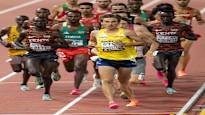Paris Olympics on channels 26.7.–11.8. Go to the competition website here. You can find the entire program of the games here.
25 athletes. This is how big the Finnish national athletics team became at the Paris Olympics.
This is Finland’s biggest athletics team at the Olympics in the 21st century. Before this, the largest team was 23 athletes – in Sydney 2000 and Athens 2004.
The best blue and white result of the current millennium is from Sydney. The team left with a gold medal, two points and five places in the finals.
The Olympic selection systems have changed over the years. While now a place in the competition requires either a result limit or a sufficient number of ranking points, 24 years ago in Sydney, in order to claim a place in the competition, an athlete had to make either an A or B limit.
The Olympic committee of each country could choose a maximum of three athletes who passed the A limit for each sport. If no drivers of the A limit were found, it was possible to choose one driver of the B limit for the racing machine.
A lot has happened in 24 years. The change can be illuminated with a playful comparison. If Sydney’s A and B limits had been used in the qualifying time window for the Paris Olympics, the Finnish team in Paris would be the size of 50 athletes.
In the Paris time window, no less than 34 women and 16 men achieved a result that would have been better than the Sydney A limit. There were 28 B-level participants in men and 21 in women. As many as 50 athletes make it to the team when the quotas for A and B levels are taken into account.
Served as the director of coaching for the Sports Association between 2000 and 2012 Jarmo Mäkelä was interested in the data.
– Yes, this surprised me a little bit, that 19 men and 31 women could have been selected with Sydney’s criteria. It follows the revolutionary trend of the 21st century. In the beginning, we lived strongly through men’s athletics and especially throwing sports. Now the situation is completely upside down: women are on display, and running sports are rushing in relation to field sports, Mäkelä states.
Instrument development and structural change have an effect
When comparing the results of the beginning of the millennium and the present, the development of tools must be taken into account, of which the renewal of pickaxes must be mentioned in particular.
– Biomechanics are quite unanimous that, for example, in endurance running, the advantage of carbon fiber spikes is two seconds per thousand meters, not forgetting sprints and jumping sports, Mäkelä states.
Although Finnish runners have approached the top of Europe in many sports, the level of results in the world is still not enough to fight for the top places. In running sports, the level of competition is so much tougher than in field sports.
Structural change in society, migration from the country to the city plays a big role in raising the level of running sports in the country.
– When I retired, we could see three kinds of structural changes: urbanization, the rise of running at the expense of field sports, and a very strong rise of girls and women.
Especially the development in women’s speed fences has warmed up Mäkelä. Development can be viewed in 12-year cycles. When Mäkelä started as head coach in 2000, the season’s top domestic result was 13.29. When Mäkelä stepped down from the position in 2012, the number one result was 13.10.
Five women have run 13.07 or better this season. About them Lotta Harala has run a Finnish record of 12.65, Reetta Hurske 12.68 and Saara Keskitalo too 12.84.
– The women’s high-speed hurdles has been a wild story, and there are new sub-13-second runners all the time behind the top, says Mäkelä.
Boundary drawing always arouses a crowd
Before the Paris Olympics, different selection criteria spoke in the Nordic countries. 11 out of 25 Finns broke the result limit of their sport, and the remaining 14 entered with ranking points.
Of these 14 hurdlers Top Raitanen endurance runner Ilona Mononen were chosen when a lot of other athletes before them did not receive an entry ticket to the Olympic Games from the Olympic Committee of their country.
Sweden left on the beach, among other things, three hurdlers who were ahead of Raita, who did not hide their disappointment.
Although the country’s Olympic Committee has the last word in Olympic selections, the selections are made in practice in accordance with the proposals of SUL and other sports federations.
When SUL considers its selection criteria for the next Olympics in the fall, Mäkelä will file a few parts of the system.
– I would start from the fact that the athletes who are eligible for selection based on the result limit or through the ranking when the qualifying time window closes are selected for the team. I wouldn’t choose cancellation seats anymore. I would put a stop on that.
– I would also put a clause that if one Finn is nominated for the sport through the ranking, he must be the best in Finland in his sport that summer.
Mäkelä emphasizes that the selection system will hardly ever produce a model that satisfies everyone.
– I used SUL’s own criteria for walks and marathons, because the limits were so loose. I got quite a lot of shit from those species groups.
Athletics at the Olympic Games starts on Thursday. See the athletics program and the Finns at this link.
